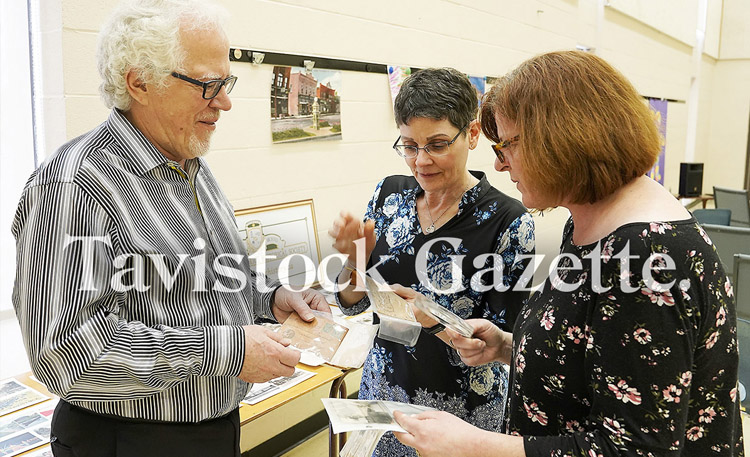Submitted by admin on

Tavistock Historical Society guest speaker Dr. Paul Bartlett looks at some rare Tavistock postcards with Society resource person Donna Wilson and newly elected director Donna Dickson (right) following the Society’s Annual Meeting on Saturday afternoon, March 30th at Grace Church.
From the Tavistock Gazette, April 3, 2019
Dr. Paul Bartlett was the guest speaker for the Tavistock and District Historical Society Annual General Meeting held on Saturday, March 30, 2019 in Zion Hall at Grace United Church. His topic was “Postcards of Tavistock,” in which he outlined the history of postcards and the methods of dating them.
“It’s a fascinating subject and I hope the interest will rub off on you,” he told the audience of 30 interested people.
After “Googling” the word Deltiologist: Someone who collects postcards as a hobby, Dr. Bartlett said he was hooked himself. He found many examples of Tavistock postcards which had been donated to the Tavistock Archives over the years. He found some in the Stratford-Perth Archives and acquired copies from local collectors including Bob Rudy, Sherrill Calder, Donna Wilson and Donna Dickson.
“There was once a ‘Golden Age’ of postcards,” he said.
“In 1903, the Dominion Government of Canada introduced the ‘Divided Back Postcard.’ This law allowed the sender to write a message on the back of the card beside the address. Prior to this only the address could be written on the back. The price to mail one of these new cards was only one cent which was half of the regular mail rate. The cheap mail rates and the frequent mail service resulted in a postcard boom. In a time before access to the telephone and before easy travel by automobile, the postcard was the way to keep in touch with your friends. The postcard was the Facebook® of the early 1900’s. In the US in 1908 alone, more than 677 million postcards were sent.”
“This postcard boom ended with the outbreak of World War I. Most of the high quality postcards were printed in Germany and with the war, access to these printers was denied. As well, a war tax of one cent was added to the cost of mailing both a postcard and a letter and that made sending a postcard a little less attractive. This Golden Age of the postcard which began around 1903 ended in 1915.”
“Most of the postcards therefore in the collection of the Tavistock and District Historical Society date to between 1908 and 1912. There is much more to a postcard than just a pretty picture. The production of a postcard requires the involvement of a publisher, a photographer, and a printer. The publisher takes the photographs of either a local photographer or one of his own photographers and arranges to produce a series of postcards of an interesting subject. The actual production of the cards, often 1,000 at a time, is done by a printer.
“The best quality postcards produced during the ‘Golden Age’ were printed in Germany. People who collect postcards are called ‘deltiologists,’ a word based on deltion which is Greek for tablet or letter.”
“Most collectors of postcards focus on a specific theme or subject. It could be their local community or steam trains or greeting cards or novelty cards and so on. Some collect the cards of a specific photographer, some of a specific publisher, some of a specific printer.”
“In Tavistock, we are fortunate to have the Lemp Studio Collection of photographs because the majority of postcards of Tavistock are based on photographs taken by John Lemp.”
Some interesting Tavistock postcards included a four-panel card which was a panorama of the village taken from the water tower. Other two-panel cards show the village 5-corner intersection. A souvenir set of postcards was also printed for Tavistock’s Centenary celebration. Dr. Bartlett noted that postcards were once used as a fundraiser for local churches. Most postcards were sold primarily in pharmacies or by Stedman Bros. There are also some very rare stereoscopic views of Tavistock available.
During that ‘Golden Age,’ sending a postcard was similar to texting today. Young women were responsible for sending most postcards. In the end, with World Wars preventing printing contracts to be fulfilled in Germany, and with the cost of sending a postcard doubling from 1 cent to 2 cents, many publishers went out of business.
Stepping back once again, with the advent of photography for the masses, Kodak introduced a service where photos were printed with a postcard back. Dating them can be based on the type of paper they were printed on, from names like Solio, Azo and others, printed on the stamp border. These were classified as ‘Real Photo Postcards’ and are much more valuable and rare for collectors.
From 1915 to 1930, white border postcards came into vogue, followed by linen-textured postcards from 1930-1945. From 1945 to the present, most cards were printed directly from photographs and covered in a photochrome, glossy finish.
“One can spend a lot of enjoyable hours delving into the story of the publisher of a postcard or of its photographer or of its printer,” Dr. Bartlett said. “That is what collectors do. Or one can simply sit back and enjoy the postcard for what it is, a beautiful work of art.”
- 30 -